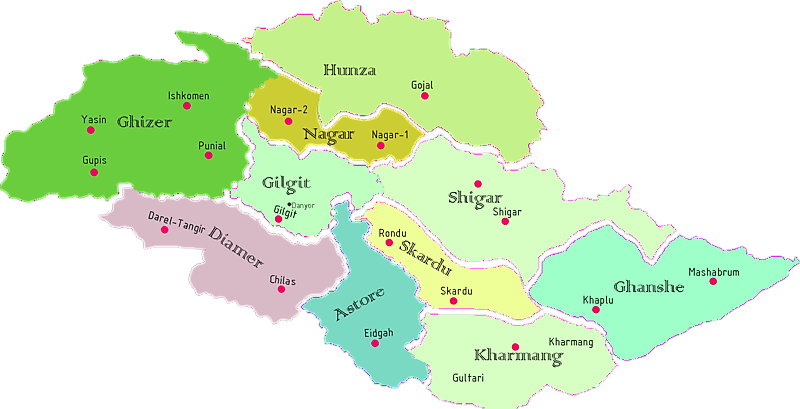Understanding spread of Covid-19 in Gilgit-Baltistan
by Dr Aziz Baig
The Coronavirus, perhaps, the deadliest in the last century that surfaced in Wuhan city of China in November 2019, has now spread to about 188 countries affecting over 27 million people and claiming over 0.8 million lives.
The World Health Organization (WHO) declared it pandemic on March 11, 2020.
In Pakistan, the first two cases of COVID-19 were reported on February 26, 2020. The two persons with initial respiratory symptoms of the virus had returned to Karachi and Rawalpindi from Iran after the pilgrimage.
The first case of Covid-19 in Gilgit-Baltistan surfaced on March 2, 2020. The patient was a 45-year-old woman who had also returned from Iran after the pilgrimage.
The pandemic started placing a heavy burden on the already overstretched health system in the mountainous region. Like many other countries and regions, the local health system of Gilgit-Baltistan was also unprepared for such a large-scale outbreak. Secondary care health facilities were without ventilators and isolation beds.
Health workers had no easy access to personal protective devices (PPEs). Because of the unavailability of internet or poor internet connectivity, most of the health service providers in remote areas had no access to online training materials on Infection Prevention and Control (IPC) and case management guidelines of COVID-19. Despite COVID-19 risks, doctors, nurses, and other medical staff in the region devotedly performed their duties to save lives.
Dr Osama Riaz and technician Malik Ashtar from Gilgit-Baltistan were the first healthcare providers in Pakistan who lost their lives while fighting Covid-19.
According to data collected by Ministry of National Health Services, Regulation and Coordination (MNHSRC), as of August 14, 2020, the deadly virus had hit all four provinces and three federally-administered areas — Islamabad, AJK and Gilgit-Baltistan– and has infected nearly 288,047 people and claimed 6,162 lives.
The confirmed cases in GB have increased to 2,452. If you look at a news website, you will see many beautiful graphics and dashboards that will provide you with the latest COVID-19 statistics revealing the number of total confirmed cases, number of tests, recoveries, and deaths.
Sometimes, you will feel relief when the overall trend on the graph is on a downward slide. Many a time, these will add to your fear and stress when the number is on an upward trajectory. The question that can be asked is: what is the best way to measure the Covid-19 outbreak? An accurate and real-time snapshot of the progress is not possible for many reasons, but there are many key metrics that can paint a picture of the outbreak’s trajectory in Gilgit-Baltistan. I have outlined here a few of those metrics to understand how successful we are in preventing the Coronavirus spread based on daily data reported by the health authorities.
DAILY CONFIRMED CASES: Daily case count is a crucial indicator of Coronavirus spread and indicates if the infection is under control.

The daily count can be confusing if reports from far-flung hospitals and labs are delayed and hence lumped into single days. To prevent the data from skewing too far in the other direction, data scientists usually use the moving average of daily new Covid-19 cases to assess the fluctuation. For my analysis, I have used a 7-day moving average. A
s shown in the graph above, the 7-day moving average of daily new cases was declining between June 6, and July 10 then again began to trend back upward, which at the time of writing this article appears to be holding fairly steady at just under 30 cases per day. The data shows that the number of new cases reported each day is on a downward trend, but the spread is not yet contained.
To know how bad the outbreak has been in Gilgit-Baltistan and how many people are infected compared to other provinces and regions in Pakistan, it is important to visualize the data per 100,000 population since the start of the outbreak.

The data in the table above shows that GB is the third most affected region, with the highest reported number of cases per 100,000 population after Islamabad and Sindh. From the beginning of the pandemic up to August 14, 129 people in 100,000 were infected. If we look at the previous two weeks, then the data shows a surprising result.
Gilgit-Baltistan has reported more cases per 100,000 in the last 14 days (@17 cases per 100,000 population). The daily case count here might not reflect the real picture on the ground as there would have been many infected people in the population who had never manifested any symptoms or might have exhibited mild ones and hence did not get tested for Covid-19.
DEATHS: Another important indicator for measuring the impact of Covid-19 is mortality.

The table above provides two types of mortality statistics. The figures on the left side show the number of deaths per 100 confirmed cases (called case fatality ratio). The right side shows a total fatalities per 100,000 population (that includes the general population, with both confirmed cases and healthy people).
The overall case fatality ratio of Gilgit-Baltistan is 2.4%, which is the third-highest in the country after Khyber-Pakhtunkhwa and Azad Kashmir. Similarly, since the beginning of the outbreak, the region has reported 3.16 deaths per 100,000 population, which is a little above the national average of 2.95.
The differences in mortality are likely due to different population demographics, characteristics of the healthcare system and differences in the number of people tested across different provinces. There could also be many other reasons which would be known after detailed research studies.
POSITIVE TEST RATE: This metric measures the percentage of people who test positive for the coronavirus of those overall, who have been tested.

The test positive rate will be high if the number of positive tests is too high or if the number of total tests is too low. A higher test positive rate suggests higher transmission, and there are likely more people with coronavirus in the community who have not been tested yet.
Gilgit-Baltistan recorded its lowest positivity rate between April 12 -May 5, at approximately 5%. After May 7, the positivity rate started climbing up and reached 28% on August 1. One of the reasons other than higher community transmission was the lowest testing rate. According to official figures, 4,613 tests were performed in May (with an average of 154 tests per day); 4,881 tests were conducted in June (with an average of 163 tests per day), and around 2,465 tests (with an average of 82 tests per day) were processed in July. It means the number of tests in July went down by almost 50%, and this can also be seen in the graph above. However, in August, the number of tests has started to increase at an average of 128 tests per day (as of August 14).
On May 12, 2020, the WHO advised governments that before reopening the test positivity rate should be at or below 5% for at least 14 days.
Gilgit-Baltistan’s seven-day moving average positivity rate stands at 16% (as of August 14), which is still higher than the WHO’s recommended positivity rate of 5%.

If we look at the test positivity rate of all provinces and regions in Pakistan, then it becomes evident that only Punjab, Sindh, Islamabad, and Azad Kashmir have successfully brought down their test positivity rates below WHO recommended level of 5%. Khyber-Pakhtunkhwa and Balochistan provinces stand at 5% and 6% respectively while Gilgit-Baltistan stands at much higher than other provinces (at 16%)
To further lower the positive test rate, the focus must be simultaneously on reducing the amount of coronavirus transmission and increasing the number of people who get tested. To further reduce the transmission of Covid-19, people of Gilgit-Baltistan need to continue complying with strict preventive measures such as wearing face masks, ensuring physical distancing, maintaining good hand and respiratory hygiene, and avoiding large gatherings.
As Gilgit-Baltistan is among the coldest regions in Pakistan so the coming winter might be a little harder than the previous ones. It could complicate the Covid-19 response if the outbreak is not controlled before the start of cold weather.
The task of finding out who is sick with Covid-19 and who is suffering from a simple respiratory tract illness will be more arduous and complicated than we can imagine.
The pressure for Covid-19 tests might push existing clinical labs to their limit. The demand for hospital beds may outpace the supply, and this could further strain an already strained health care system in Gilgit-Baltistan. It’s time to stay more cautious and act responsibly to help the government in controlling the spread of the disease.

Dr Aziz Baig is a medical professional with a master’s degree in Public Health from the London School of Hygiene and Tropical Medicine. He hails from Gilgit-Baltistan and currently working as a Country Medical Coordinator for an international development agency in West Africa based in Nigeria. He is an avid writer and contributes articles on health issues in developing countries for Huffington Post, Dawn, Friday Times, Daily Times etc.
.

The High Asia Herald is a member of High Asia Media Group — a window to High Asia and Central Asia

